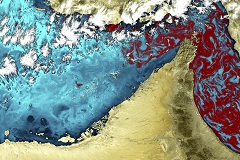
Red Tide detection and water quality monitoring in the United Arab Emirates (Arabian Gulf) in support of human health and desalination plants operation against harmful algal blooms.
The coast of the United Arab Emirates (UAE) in the Arabian Gulf and Oman Sea hosts some of the largest desalination plants in the world (in 2011 it was the second producer of desalinates sea water, after Saudi Arabia and their operation is linked in two ways to the status of the water quality near the coast: from one side the water they release could have an impact on the coastal ecosystem and from the other side they can be strongly affected by not-harmful and harmful algae bloom (HAB).
In particular, the local phenomenon known as Red Tide in the last 4 years had a relevant impact to desalination plants operation, causing severe damages and stopping the operations for many weeks.
The Coastal Water Attribute Monitoring using Satellite data (C-wams) project – funded by ESA under the Value Added Element (VAE) of the EO Envelope Programme – aims at implementing a suite of Earth Observation (EO) products and data services specifically targeting two growing sectors: Waste Water Treatment plants and Desalination plants.
The main objectives of the C-wams projects are:
- To start from existing assets, define and setup – together with the user(s) – realistic and feasible service and products for supporting their activities in waste waters and desalination plants;
- To implement and demonstrate those products and services over two test areas chosen together with the user(s);
- To assess the service performance and the service utility, getting the user(s) feedback for identify issues/solutions and improvements;
- To elaborate a plan for a wide service uptake within the framework of the international (e.g. European Marine Directive) obligations.
To fulfil its scope the C-wams project, building on existing prototype EO products, aims in implementing and demonstrating a monitoring service able to derive Near Real Time (NRT) Water Quality (WQ) parameter and HAB detection from medium resolution sensors like MERIS and MODIS and to detect.
The consortium developing the C-wams project is composed of TechWorks (Prime, Irl) and Planetek Hellas (Gr), which leads the study case about Desalination Plants in the UAE.
The study case in UAE is aimed at identifying HAB (in particular Red Tide) events by detecting anomalous values in some water parameters using MERIS data, with the further support of higher resolution images (i.e. RapidEye and Pléiades) to empirically retrieve Chlorophyll concentration (Chl) and Total Suspended Matter (TSM). Moreover, when a HAB alarm is issued, the use of a very high-resolution sensor (like DubaiSat-1 or Pléiades) is considered to be used for a precise determination of the HAB extent, giving a concrete support in preventing and forecasting its effects.
The service trial involves the EAD (Governmental agency committed to protect and manage biodiversity, to provide a clean environment and to promote sustainable development in the Emirate of Abu Dhabi) as user and its objective is to demonstrate the capability of EO derived products to support users’ current practices concerning environmental protection by efficaciously monitoring WQ parameters (in particular) with the aim of detecting, in near real time, the occurrence of HABs events, like the Red Tide.
From a first analysis of the use of the Red tide Index (RI) for HAB/Red Tide detection, the following conclusions can be derived:
- the use of RI, combined with a set of thresholds, appears to be a useful parameter to detect HAB/Red Tides
- RI proved to be a robust tool, in respect to Chl alone
- preliminary results show that integrating FLH and/or MCI can improve the detection
- From these outcomes, an outline of the next steps to be performed has been made:
- to investigate the use of other parameters like FLH, MCI, SST and TSM to detect false HAB alarms
- to perform and evaluate the integration of daily MODIS data
- use of in situ data to be received by the user
Furthermore, high-resolution products would be implemented and applied to the HAB detection.
Project information
Client information:
European Space Imaging
Application fields:

